The Ultimate Guide to Banff, Jasper & Yoho Camping
Get the details on Banff, Jasper, & Yoho National Park camping with information on reservations, overflow camping, & convenient campgrounds.

Camping in the Canadian Rockies – especially Banff, Jasper, and Yoho National Parks – is an amazing way to explore the vast area because it puts you right at the heart of all of the trails and other adventures that the Parks have to offer. Camping in National Parks does require a bit of advance planning, as the campgrounds fill up months in advance.
In this blog post, I share camping tips from my Canadian Rockies road trip, including my favorite campgrounds, which ones you can reserve in advance, and advice if you miss the boat on campground reservations, or simply prefer to be spontaneous.
This post may contain affiliate links.
Plan your Banff, Jasper, and Yoho National Park camping trip with our guide below!
Important Reminder: As it goes in all of the destinations we share, please practice good trail etiquette and remember to Leave No Trace. This means packing out all of your garbage (including toilet paper), being respectful to others on busy trails, and following the established rules.
Banff, Yoho, & Jasper Camping Basics
To camp all of the Canadian National Parks you will need the following.
- A National Park permit: National Park permits are available at the entry gates, visitor centers, and campground kiosks, or online.
- A camping permit: Some campgrounds in Banff, Yoho & Jasper accept advanced reservations for camping permits online. Others are first come, first served. Cost varies between sites.
- A fire permit: Fire permits can be purcahsed at the time of your reservation, or at a campground kiosk. They are $8.80 per site per night and include your firewood (as of August 2021). If you don’t want to have a fire, then you can save some dough.
Other tips:
- Pets are allowed in the National Park campgrounds but must be on a leash at all times.
- Be bear aware! All campsites have bear proof boxes where you should store your food. Don’t leave food out on picnic tables unattended, even for a couple of minutes while you go to the bathroom.
- There is no “free camping” in Banff, Yoho, & Jasper National Parks, like we have on BLM Land in the US. You are only allowed to stay in designated sites, and I wouldn’t recommend trying to sneak around and sleep in a trailhead parking lot overnight. These lots are patrolled, and they do make people move. I “stealth-camped” one night of my trip off the Icefields Parkway where all of the sites were full and was paranoid the entire night about getting busted.
- If you snag a first-come, first-served site that you like, set up shop there for a few days and explore around there. You’ll have a better time if you don’t have to search for a new campsite every single morning.
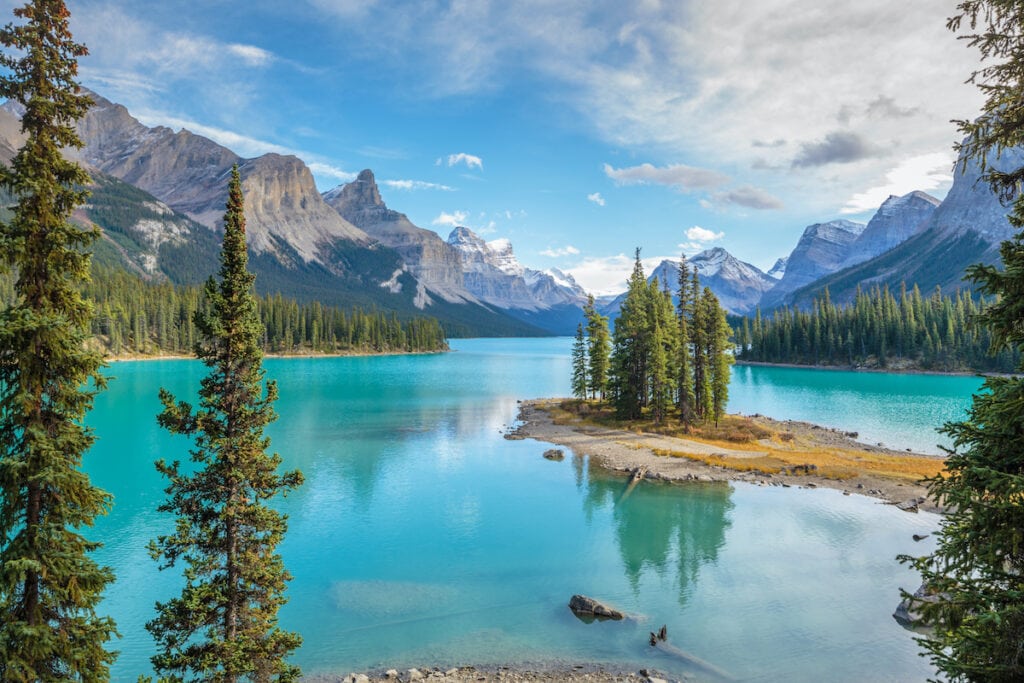
Save this post!
Enter your email & I'll send this post to your inbox! You'll also receive my weekly newsletter full of helpful advice for planning your adventures.
Banff National Park Camping
Please note: this campground guide was last updated in August 2021, so please check the official parks website for the most up-to-date information regarding reservations and fees.
Banff camping is divided into two areas; Bow Valley Campgrounds and Icefields Parkway Campgrounds.
The Bow Valley Campgrounds include the campgrounds in the towns of Banff and Lake Louise, plus all of the campsites in between. The Icefields Parkways Campgrounds include everything north of Lake Louise until you get to the Jasper National Park border.
There are 2,462 sites located within 14 campgrounds, so options are plentiful, although it’s also one of the most popular areas in the Canadian Rockies. For that reason, if you know your dates, we strongly suggest making reservations so you won’t have to worry about not finding a spot.
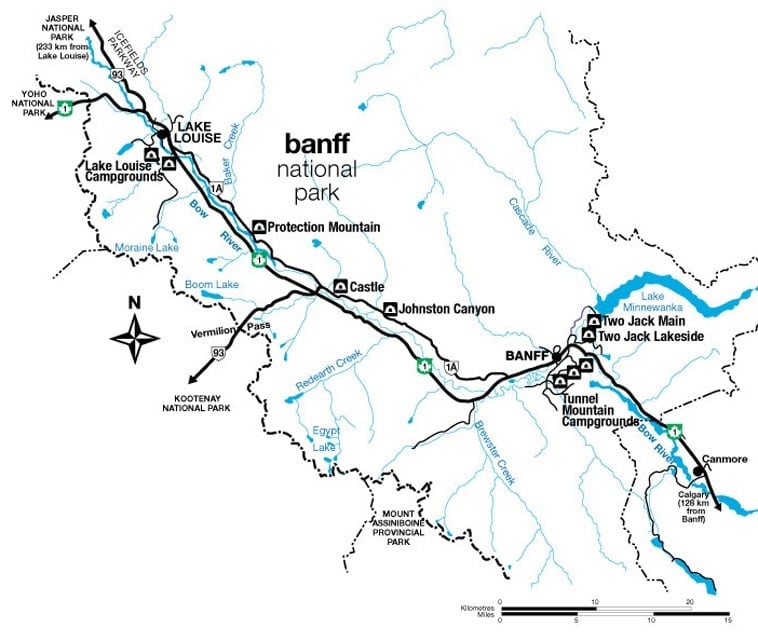
Campgrounds Closest to the Town of Banff
If you want to explore the town of Banff, the closest campgrounds are the Tunnel Mountain Campgrounds and the Two Jacks Campgrounds, followed by Johnston Canyon. 100% of the sites at these campgrounds are reservable by advanced reservation.
Tunnel Mountain Campgrounds
If you want to be able to hop on a quick bus and head to town, then the Tunnel Mountain Campgrounds are the best choice. The Tunnel Mountain Campgrounds also have showers, while the Two Jacks campgrounds do not. The Tunnel Mountain Campgrounds are also the only campsites near Banff with hookups. So if you need electricity you’ll need to stay here. At the Tunnel Mountain Campgrounds, there are over 700 sites, and you kind of feel like you are in a giant parking lot. These campgrounds do have pretty views of the mountains if you don’t mind looking past the pavement and your neighbor’s RV. You are paying for convenience and amenities at Tunnel Mountain.
Two Jacks Main and Lakeside Campgrounds
The Two Jacks Main and Lakeside Campgrounds feel a little wilder. It’s harder to get to town by public transportation, but you’re right next to Two Jack Lake which is a great spot for sunset. Lake Minnewanka is also right around the corner with a lot of nice trails to explore.
The Two Jacks Main and Lakeside campgrounds are more spread out, with sites spread throughout the trees. If you’re on top of your planning and lucky enough to score one of the campsites right on the shore of Two Jacks Lake, you’ll be a happy camper and should plan on staying a few nights.
Two Jack Lakeside campgrounds also has equipped campsites that includes the full shebang; a 6 person tent, 6 sleeping pads, a stove with propane, a lantern, and even a broom with a dustpan. Don’t forget food, sleeping bags, and your clothes!
Johnston Canyon
Johnston Canyon Campground is about 30 minutes from the town of Banff, and it is very busy due to the popularity of the Johnston Canyon hike which is right across the road. If you do end up getting a spot at Johnston Canyon campground, use it as an opportunity to get up early and hit the Johnston Canyon trail before the rest of the crowds arrive.
[images_2_col image_1=”33331″ image_2=”33332″ /]
Campgrounds Closest to Lake Louise
Lake Louise has a large campground right off the highway and next to the train tracks, and it is separated into two areas – one area for trailers and another for tent campers and small RVs (up to 24ft). The tent-camping area is surrounded by a fence to keep the bears out, and you are not allowed to pitch a tent in the trailer area. The trailer area includes hook-ups.
The Lake Louise campgrounds have hot showers and flush toilets and consists of pull-through sites where you share a parking spot with your neighbor. It’s not the most scenic, but it is the most convenient to Moraine Lake, Lake Louise, and the surrounding trails.

Campgrounds on the Icefields Parkway in Banff National Park
North of Lake Louise, you’ll find Mosquito Creek, Waterfowl Lakes, and Rampart Creek Campgrounds. Rampart Creek is reservable and the rest are first-come, first-serve. If you are trying to get a campsite at one of these, I recommend arriving early. Every time I tried to stay at one of these, they were already full. If you want to stay here, don’t leave your campsite search for the end of the day. Instead, head to the campground you want to stay at first thing in the morning, and snag a spot right as someone is leaving. Don’t be picky, or you might not end up with a campsite at all. I learned this the hard way. Once you find a site, then go explore for the day.
Banff National Park Overflow Camping
I showed up to Banff with no plans and all of the sites on the website were already reserved. I wouldn’t recommend this, as it ended up being quite stressful. Every morning I had to rush to find my next campsite, and I ended up planning my day around where I could find an available site versus what I actually wanted to do. If you end up in a similar situation, you aren’t completely out of luck. Here are some tips and places you can stay:
- First go to your campground of choice early in the morning: The campgrounds in Banff often have last minute cancellations. Or people will leave a day early. In this case, people looking for a site will line up first thing in the morning and wait for the campground to vacate. Once they have open sites, the ranger will give sites out on a first-come, first-serve basis. Sometimes, you’ll be able to stay for more than one night, so ask when you are being checked in. I was able to get sites at both Tunnel Mountain and Two Jacks Main this way.

- Banff overflow camping: The Tunnel Mountain Campground offers overflow camping at the back edge of the campground. You are required to sleep in your vehicle (no tents) and sites were a little cheaper than a normal campsite. This is really just a place to park and sleep that provides access to the bathrooms.
- Lake Louise overflow camping: the Lake Louise overflow camping was in a dirt parking lot right off the highway. Again, this was only for people sleeping in their vehicles, and no tents were allowed. I much preferred the Banff overflow over the Lake Louise overflow. The only plus side of the Lake Louise overflow is they were running shuttles up to Lake Louise and Moraine Lake that left from the same parking lot.
Jasper National Park Camping
If you head north from Banff on the Icefields Parkways, eventually you’ll cross the border into Jasper National Park. Jasper is slightly less busy than Banff, and I had a little better luck here finding a campsite without an advanced reservation.
All of the reservable campgrounds in Jasper are circled on the map below in red. All of the non-reservable campgrounds in Jasper are circled in blue:
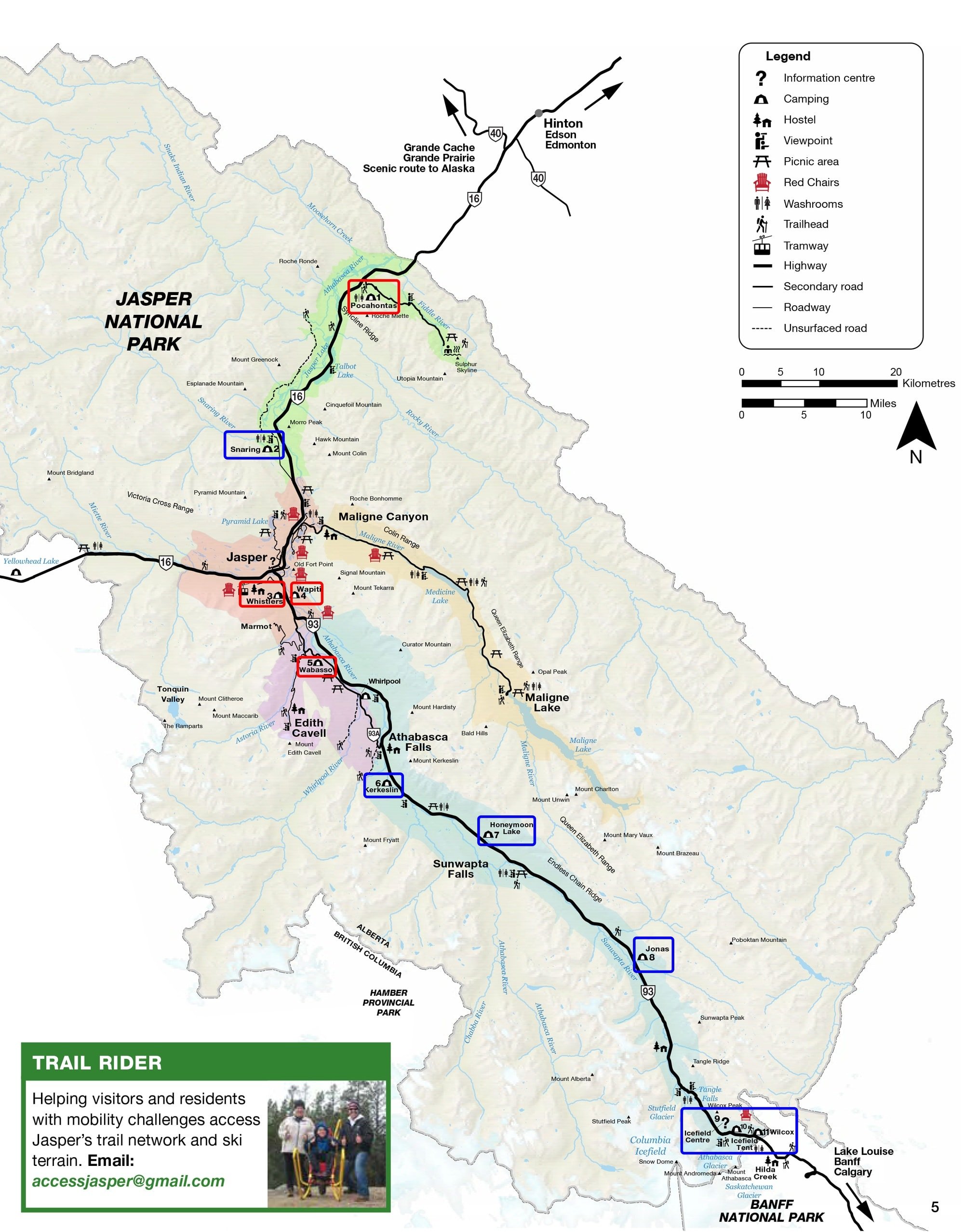
Campgrounds Closest to the Town of Jasper
The campgrounds that take advanced reservations that are closest to the Jasper township are: Whistlers, Wapiti, and Wabasso. Pocahontas Campground also takes advanced reservations, but it’s a little further from the action – which can be good or bad depending on what you are looking for. Campground information and reservations can be made here.
Whistlers Campground has over 780 sites and has nightly evening shows all summer. There are also oTENTiks at Whistlers, aka glamping. oTENTiks are fully set up tents with wooden floors, beds, seating and even heaters. They can fit up to 6 people with a maximum of 4 adults.
Wapiti Campground is the campground I stayed at along the Athabasca River. I didn’t have a reservation and used the same tactic as I did in Banff – get up early and see if they have availability. Luckily I was able to get a Wapiti campsite for a couple of nights without too much hassle. Wapiti is open year-round if you want to beat the crowds in the summer and visit in the winter.
Snaring River Campground
I also stayed in the Snaring River Campground, which is first-come-first-serve, and preferred it to Wapiti. It’s a little more off-the-beaten-path, but still close enough to Jasper township that you can enjoy what the town has to offer. There are no showers, and be ready to use your bug spray.
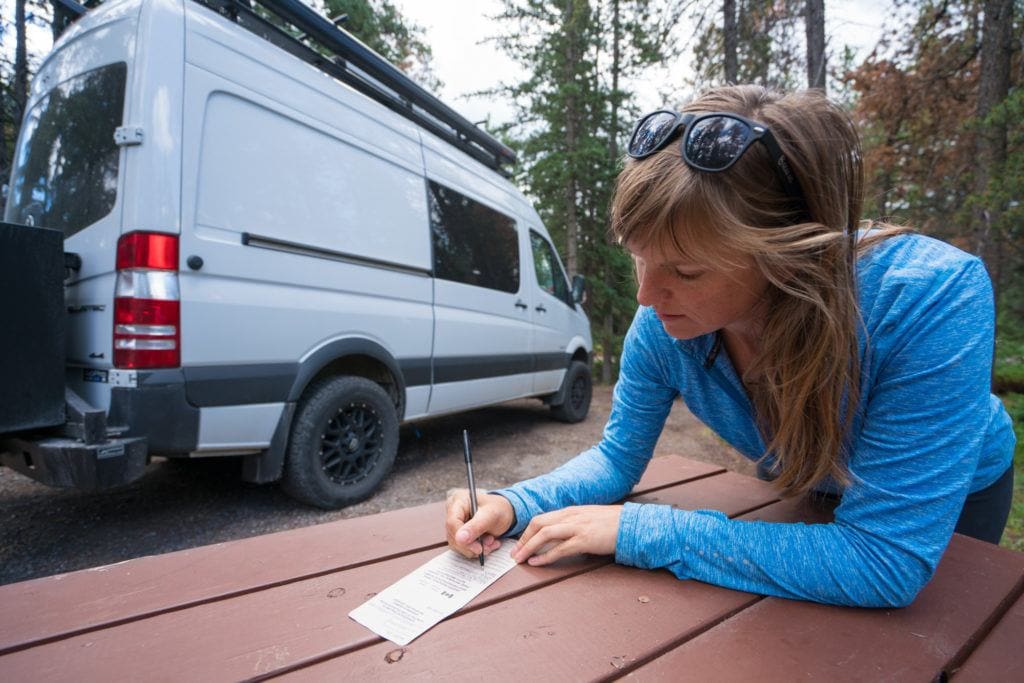
Campgrounds Along the Icefields Parkway in Jasper
There are a lot of first-come, first-served campgrounds spaced out along the Icefields Parkways once you cross into Jasper National Park. I’d estimate that it’s a 30-minute drive between each one, and like Banff, they fill up in the morning. If you know you want to stay along the Icefields Parkway, find your campsite first and then head out for your day’s adventure.
Jasper Overflow Camping
If you can’t get a spot in the main Jasper campgrounds or any campgrounds along the Icefields Parkway, you have a couple of options.
- Snaring River Overflow Camping: This is a great option right next to the official Snaring River Campground. It’s a big field with open camping. It costs just over $10 and is only available if all of the other campgrounds are full.
- Columbia Icefields Center Parking Lot: They allow RVs and Campervans to park overnight in the big parking lot at the Columbia Icefields Center. There is a toilet, but nothing else. I stayed here for one night and for a parking lot, the views couldn’t be beat.
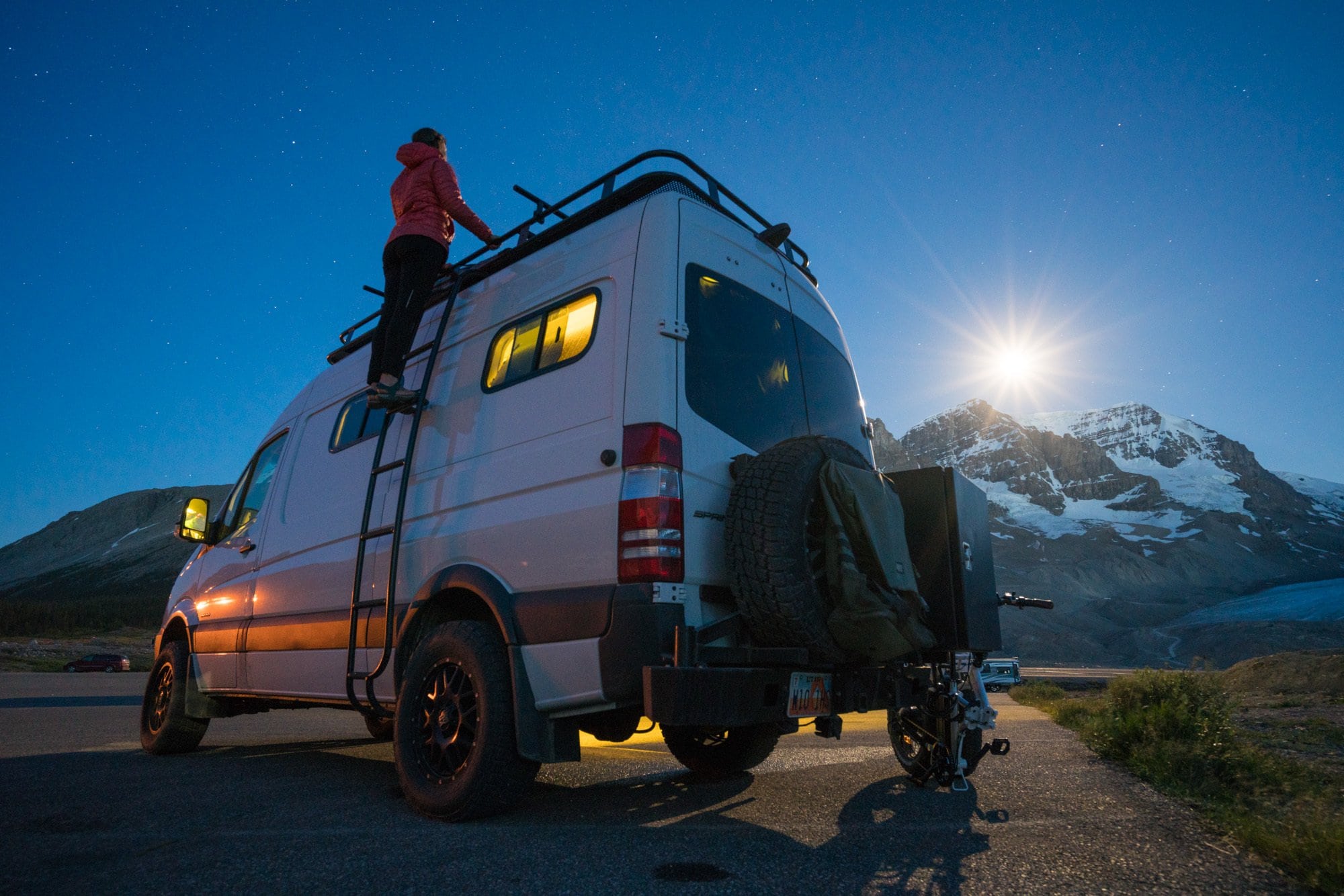
Yoho National Park Camping
If the campground lists above for Banff and Jasper National Parks overwhelmed you, don’t fret. Yoho National Park only has 4 campgrounds with slightly over 150 sites. Yoho National Park had some of the best hiking trails (in my opinion), so one of Yoho’s campgrounds is a very convenient place to base yourself for a couple of days during your road trip. Yoho is located just west of Lake Louise.
Campgrounds are generally open from mid-May to mid-October but vary from campground to campground. All Yoho National Park campgrounds are available first-come, first-served, except for Kicking Horse Campground. Campgrounds are busiest on holiday weekends and all weekends in July and August.
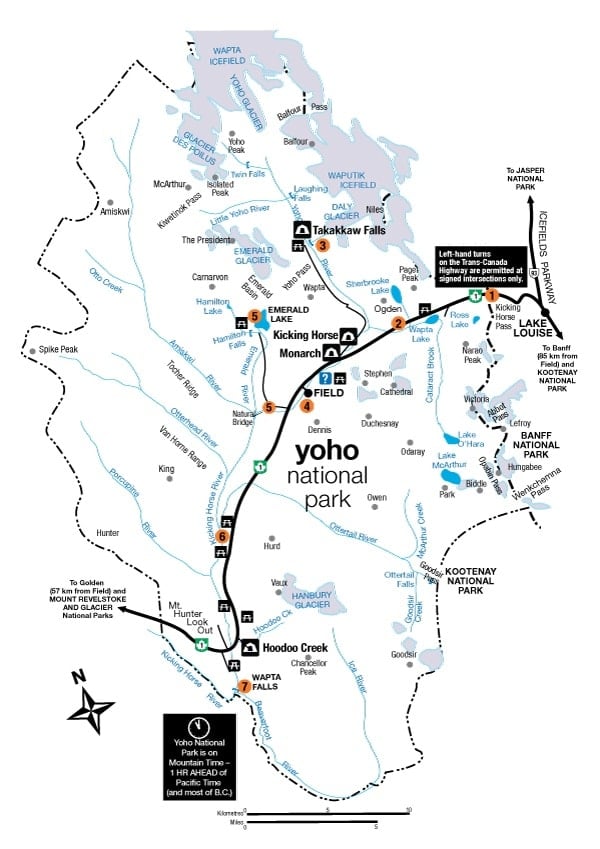
In Yoho National Park, Kicking Horse Campground is the largest with 88 sites and is the only one with flush toilets and showers. The rest of the campgrounds are small and pretty primitive. Kicking Horse requires camping permits from mid-June until mid-September.
Right next door to Kicking Horse is the much smaller Monarch Campground. Here you’ll only find pit toilets, along with some pretty incredible views. The first night when I arrived in Yoho, both Kicking Horse and Monarch were full, but they allowed overflow parking across the road from Monarch in a dirt lot next to the railroad tracks.
Kicking Horse and Monarch the most centrally located campgrounds in Yoho. From there you can easily drive up to Takakkaw Falls or the Iceline Trail, as well as Emerald Lake and it’s nearby trails. You can also drive into Field which is a cute small town with a couple of places to grab some grub, as well as a liquor store.
If you are tent camping, then your best option for a quiet and scenic experience is the walk-in sites at Takakkaw Falls. I also recommend checking out walk-in camping at Lake O’Hara for a truly special camping experience.

What to Pack for a Canadian Road Trip
Weather can change very quickly in the Canadian Rockies, and it is important you are prepared. I suggest bringing rain gear, regardless of the predicted forecast for your travels, and I recommend carrying it with you on your day hikes along with your other day hike essentials.
The average high temperature during the day in spring and summer ranges from 50° (F) to 65° (F) though temperatures at night can drop below freezing. In late June, we got everything from hot sun to rain to snow. Some days were quite warm and nights got into the 30s (F). While you might be camping during the summer you need to ensure your sleeping bag has a good rating for temperatures below freezing. Packing extra blankets to be safe is a great idea, along with a groundsheet for your tent to provide extra insulation with dropping temperatures.
Remember to be bear aware, and always carry your bear spray. The Parks suggest hiking in groups, and if you choose to hike alone, they recommend talking out loud (yes, to yourself) and clapping before you turn any corners. The worst thing you can do is surprise a bear on the trail.
Don’t forget that the Canadian Rockies are high in elevation so you’ll want adequate sun protection with sunscreen and a sun hat. Trekking poles were very helpful on the steeper hikes.
For hiking clothing, you’ll want lots of layers, including an insulated jacket, a hat, and gloves.
Read next: Looking for trail recommendations? Check out our guide on the Best Hikes in the Canadian Rockies.
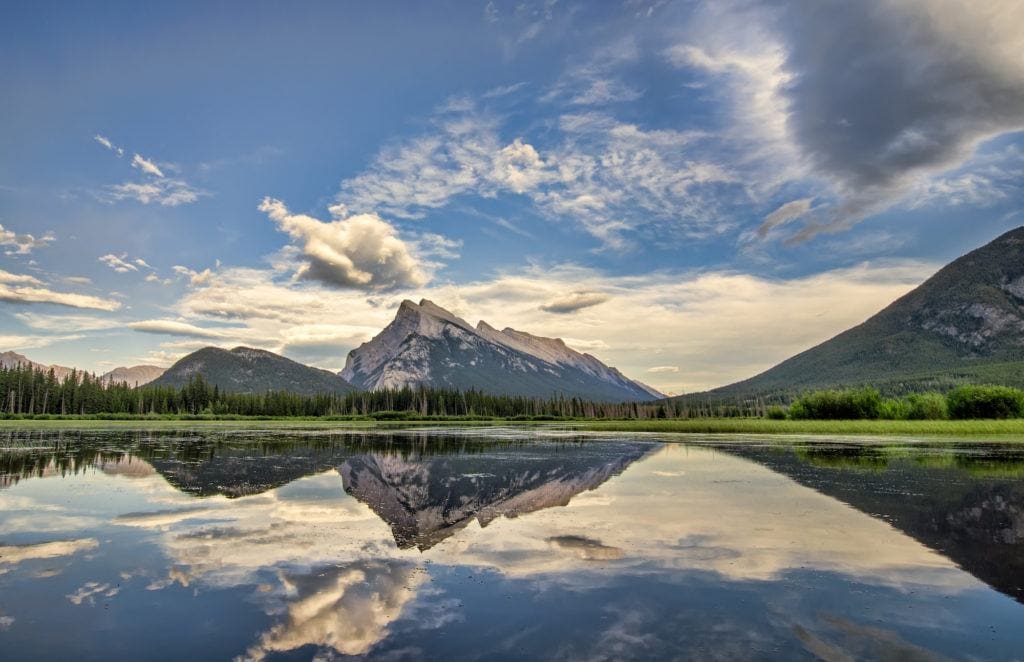
Top Resources I Used to Plan My Canada Trip
Are you planning a camping trip to the Canadian Rockies? If you have questions, make sure to leave them in the comments!



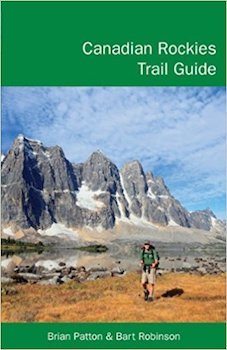
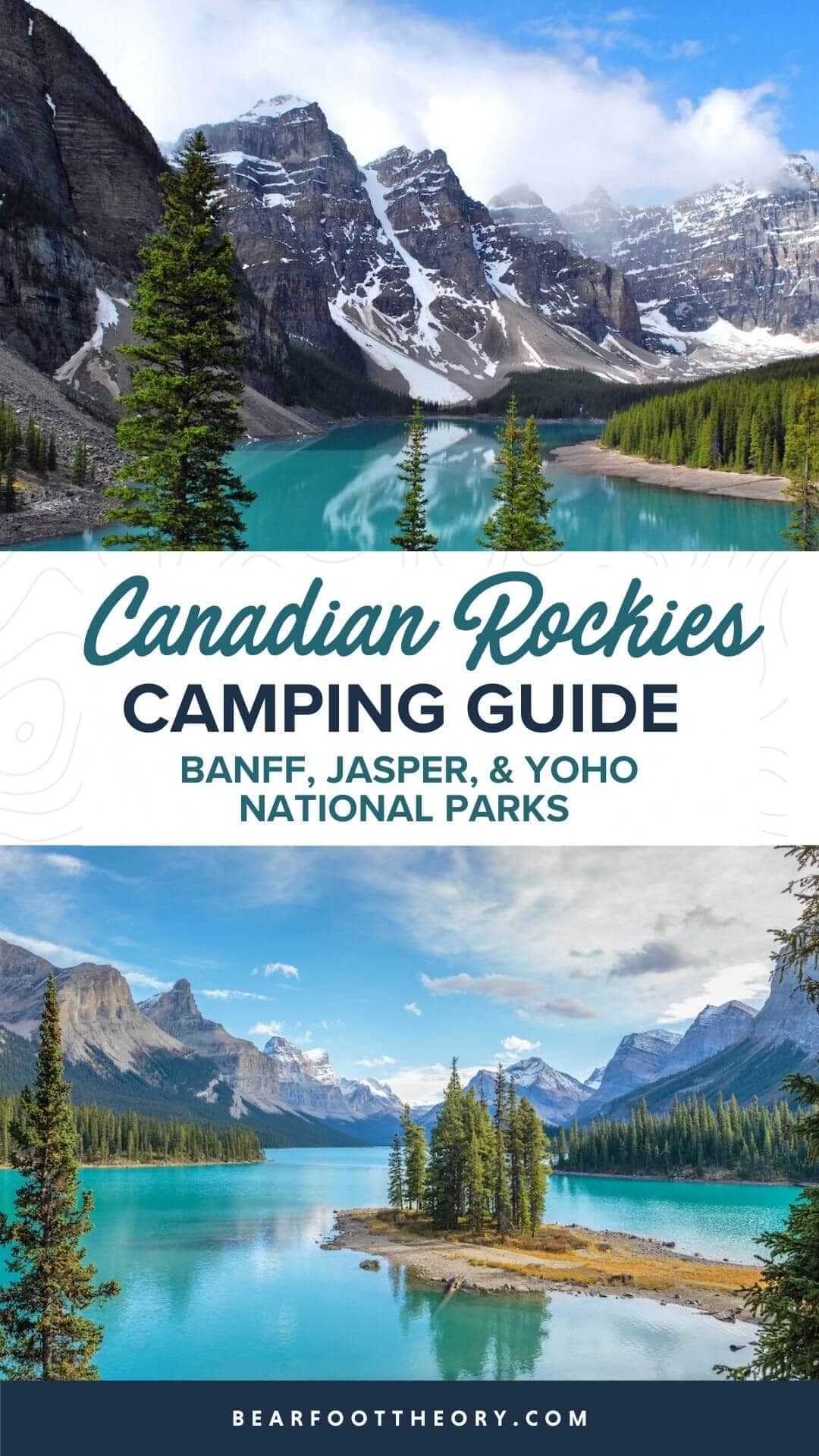
This was so helpful; thank you! We are going to fly into Calgary in July and rent a camper van. I appreciate having all of this info in one concise place. Thanks again!
Thank you for all this helpful information! In your experience, how early should we be at the campground to snag a camp spot? Is 8:00 early enough, or should we be there early in the morning around 6:00?
Hi Paige, the earlier the better to be safe! Have an incredible trip.
Thanks for the info! Let’s see if we’re lucky and we get to book some places! I still remember waking up at 3 am to take a place at Glaciar Nat Park! Let’s see how this all work. Great info.! Thanks And congrats for leaving your job and doing what you actually love! Brave decision!
i just “pulled a Kristen” and quit my job to travel!! 🙂 i’m starting off with a two month solo road trip w/my pup. i’m planning on car camping with banff & jasper on the list. this is an awesome article…you have so many great tips. thank you for the guidance and inspiration! this is an older post but curious about your thoughts on me leaving my tent set up at sites during the day across various national parks in CAN and US? i’ll have to drive btwn locations with the pup. thx!
Hi Christy!
Where are you in your travels now?! I’ll pass along your sweet comment to Kristen. I feel like it’s fine to leave your tent set up at your camp while you’re out and about exploring in the daytime. But, we also encourage you to use your best judgement. If it doesn’t feel right, don’t do it. Otherwise, it’s a common practice to leave camp set up during the day. Safe travels and enjoy the journey! – Mary Kathryn
This is awesome information!! Thank you so much !!
We’re so glad you found it helpful! Have fun out there.
Hey,
We are looking to do RV camping for Banff and Jasper in Aug next year. We are a couple with 2 boys 9 and 11. Do you think a typical RV 28” will be convenient to drive from Calgary to Banff to Jasper back to Calgary? We have driven 30” RV in Alaska for a 2 week trip. Alaska’s terrain was easy to RV. Plenty of RV parking and wide roads and not so much elevation driving. So we are not entirely new to RVing. But my question is more about the terrain and ease of driving in Canadian Rockies. Could you please provide some thoughts on this?
It really depends on where you’re going in the Canadian Rockies. Any of the National Parks like Banff and Jasper will be very easy to navigate in an RV as they’re similar to US Parks.
I am trying to book a site. What happen to this system, I am since 4 am , and couldn’t get through
Does someone can explain that? Just want to book a camping site in Banff
Hi Meiry – unfortunately it’s not possible to book a campsite through our site. You’ll have to visit the Banff National Park website to book campsites